Let’s talk TED Hose! What are T.E.D hose anyways?
T.E.D. Stockings are designed to cure certain certain circulatory problems in a non-invasive (non-surgical) way. Typically, T.E.D. stockings are used after surgery to assist in blood flow while the patient is stuck in bed. Remember the old saying… “TED s are for BED s”
If you or someone you love has ever visited a doctor or hospital to treat an embolism or varicose veins, then you may have to come to appreciate TED Hose as a powerful treatment for certain medical ailments.
The acronym T.E.D. stands for “thromboembolism-deterrent”.
TED Hose are compression socks that are made specifically for the management of DVT (deep vein thrombosis), as well as prevention of venous distention that sometimes occurs as a result of surgery, and some other ailments related to the legs.
TED Hose – T.E.D. (“Thrombo Embolism Deterrent”) is designed as a preventative non prescription treatment against blood clots (embolism) while you’re in the hospital after surgery
In this article, we’ll answer your questions about various aspects of T.E.D. hose and Compression Socks, and we’ll take a look at how they might impact your life for the better!
T.E.D stockings help to enhance blood flow in the legs with the use of compression.
TED Stockings (also known as “TED Hose” or “T.E.D. Socks”) are not the same as Compression Socks. There are some critical differences we need to address. First up, TED Hose are non ambulatory. Compression Stockings are Ambulatory. What does this mean? Simply, “TED s are for BED s”. TED Hose are for being in bed after surgery. Compression Socks (also known as Compression Stockings) are for walking around.
What Is The Difference Between T.E.D. Hose and Compression Stockings?
The general catch-all phrase of compression stockings or compression socks is often used to encompass the more specific category of T.E.D. stockings.
Although they are not technically the same, even some professional health practitioners will refer to all compression garments as T.E.D. stockings or pantyhose.
However, it is important to understand the differences between the two so that you can make sure you are using the correct one for your situation.

T.E.D. Hose:
Thrombo-Embolic Deterrent Hose, or T.E.D. hose as they are popularly known, are used for patients who are non-ambulatory (persons without the ability to move around), especially immediately after surgery, to help the blood flow freely in the legs to prevent blood clots.
The pressure level of T.E.D. stockings is typically below 20mmHg, and its highest point is at the calf. These types of T.E.D. hose are available in thigh-high or knee-high, and may even come in a variety of colors (although white has been the standard for many years).
Note:
The measurement scale of compression stockings uses mmHg –millimeters of Mercury– indicates the amount of pressure the stocking places on the legs and is the same measurement used for blood pressure cuffs. The very lowest in the compression stocking range is about 8 mmHg but it can go as high as 40 mmHg.
Because blood usually pools at the calf, especially when in bed, the pressure in T.E.D. stockings is meant to force the blood back up the legs so that it can return to the heart easily and avoid clotting or DVT. The lifespan of T.E.D. hose is fairly short, typically lasting a few weeks to a couple of months before they need to be replaced.
Compression Socks:
Compression stockings are prescribed for ambulatory patients. (Walking Around)
These are considered to be patients who are mobile but are suffering from circulatory problems that need a high level of pressure. Patients with conditions like varicose veins or lymphedema may need to wear compression socks.
Compression stockings are perfect for patients who can move but might still fight against the pain or discomfort of a circulatory condition. In these, the level of pressure may vary at different levels in the garment.
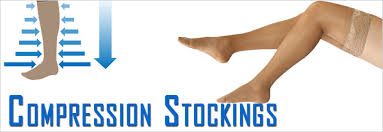
The levels for compression socks are usually divided into 3 ranges: 15-20 mmHg, 20-30 mmHg, and 30-40 mmHg.
Some patients may require pressure levels as high as 60mmHg, but this is rare and would be a special circumstance for a doctor to decide upon.
Generally, TED Hose (also called TED Stockings, T.E.D. Hose, or simply T.E.D. s) have lower compression.
Compression Socks (also called Compression Stockings or Support Stockings) have higher compression.
It makes sense. When you’re standing up, gravity is pushing blood into your legs. This requires more compression. Hence “Compression Stockings”.
When you’re lying down, gravity is not pushing all your blood into your legs. This requires less compression. Hence TED or “Thrombo Embolism Deterrent”.
For most brands of TED Stockings, the pressure is graduated throughout the sock, usually higher at the ankle, where gravity places more pressure on the veins when the patient stands. The pressure then gets lower as it moves up toward the calf, where the pressure is less needed.
People who suffer from extreme medical conditions such as edema, blood clots or DVT (Deep Vein Thrombosis) may be prescribed a lower pressure of compression stockings or TED Hose than those suffering from varicose veins or other issues.
People with lymphedema or swelling at the legs may also benefit from the use of TED Hose or Compression Stockings.
A person’s doctor will indicate the style of compression socks or stockings (short, long or tight-style) depending on the specific needs of the individual.
Compression socks are durable, should be washed every time they are worn and can be made to last for three to even six months if they are well-cared-for.
While they used to only come in rather bland white, both Compression Socks (and to a lesser extent TED Socks) are now provided in fashionable colors and styles.
The significant distinction between Anti-Embolism Stockings (T.E.D. pantyhose) and Compression Socks is two-fold:
based on the amount of pressure as well as the reason the person is wearing them.
When measured, Anti – Embolism Stockings (TED Hose) range between 8–18mmHg while compression socks will usually range from 15–20mmHg or higher.
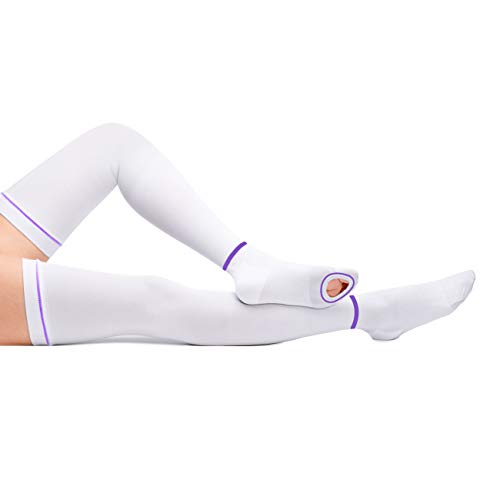
Compression Stockings and Socks are used in the treatment of lymphatic and venous disorders in the category of patients referred to as ambulatory patients.
Graduated Compression Stockings are worn by people with all types of Chronic Venous Insufficiency, from varicose veins, stasis skin changes, edema, and venous procedures.

They can also be used to prevent Post-Thrombotic Syndrome and treat such as well. Medical research has proven that ambulatory patients with Chronic Venous Disorders need more pressure than low-pressure T.E.D. stockings can offer.
A Simple Rule of Thumb:
- For bedridden patients, use anti-embolism T. E. D. products called TED Hose
- In the case of ambulatory patients, use Graduated Compression Stocking products called Compression Socks
If you’re stuck in bed, wear TED.
If you can walk…sorry I don’t have a clever phrase. It’s just compression socks then.
When patients use the right compression garments, it can speed up the healing process while keeping them safe from Deep Vein Thrombosis (DVT) and other venous conditions.
Using the wrong pressure of Compression Socks or T.E.D. Stockings is unwise. Do your research. If you’re having surgery, check with a medical professional (like a nurse or doctor) to verify your TED Hose are the right pressure and sizing.
Should Nurses Use T.E.D. Stockings or Compression Socks?
You may have heard nurses and other medical professionals say they wear compression stockings or T.E.D. pantyhose. In the world of nursing, and other occupations when people spend a ton of time on their feet, it is often indicated that people wear compression socks in order to counteract the negative impact of gravity on the veins.
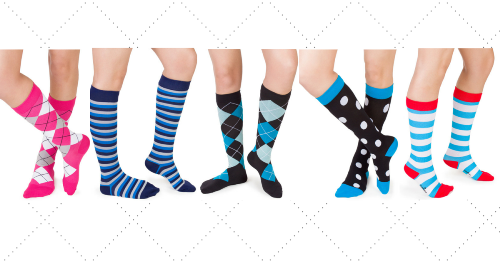
TED Hose could possibly prevent spider veins, varicose veins or other problems with the circulatory system.
However, since T.E.D. hose is indicated for those who are bedridden, these are not effective for standing people (like working nurses, airline pilots, travelers, etc…)
Instead, people walking around should be using graduated compression socks to help prevent fatigue and promote healthy circulation.
Do I Need T.E.D Anti-Embolism Stockings?
Anti-embolism stockings should only be worn when a person is recovering from a long illness or surgery, or the person is bedridden.
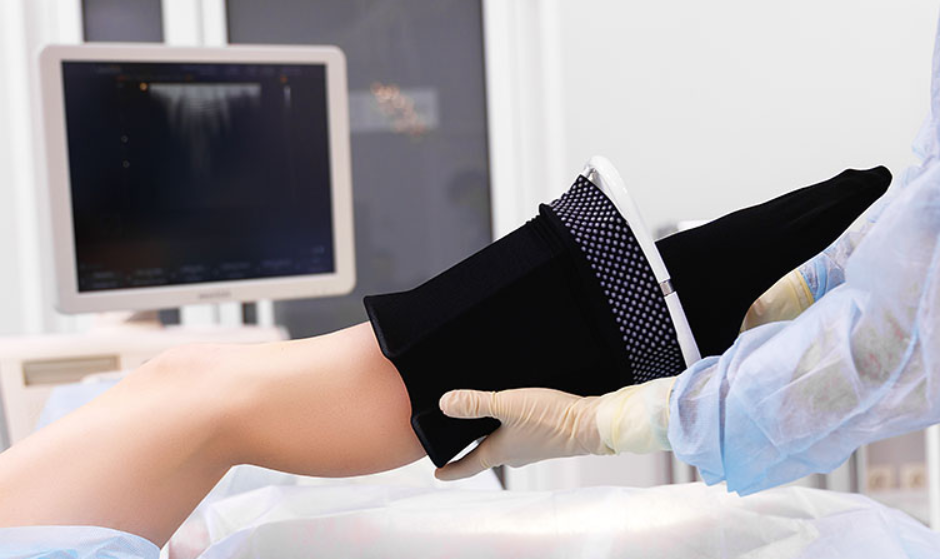
They may be useful for a person who is recovering from surgery or a woman who has been put on bed rest due to high risks in pregnancy.
These specialized garments aren’t meant to be worn when a person is walking around, going about his or her daily routine.
Compression socks or stockings may be worn anytime a person steps out of bed and can be used for treating medical complications such as fatigue, achy legs, varicose veins or deep vein thrombosis. The pressure is available on a variety of levels and is meant for people who are at least somewhat active.
Do I Need a Prescription for T.E.D. Stockings?
Non-ambulatory patients often get a prescription from a doctor before using T.E.D. Stockings.

When a person is in bed for long periods of time, they are more likely to have problems with blood pooling in their legs.
These patients get this prescription because health care providers know that non-ambulatory patients with low mobility run the risk of developing a blood clot in their legs.
This type of condition is very dangerous because clots can break free and move through the bloodstream to the lungs, leading to pulmonary embolism.
When non-mobile patients are prescribed T.E.D. stockings (TED Hose), their risk of blood clots will be reduced and their ability to recover is better and faster.
In these cases, yes, you’ll need a prescription but that’s okay because you’ll already be under the care of a doctor anyway. Once the person becomes mobile, it will be up to the discretion of the doctor if they will continue to need to use T.E.D. stockings on a regular basis.
The Many Names of Compression Socks
Either TED Stockings or TED Hose are designed to be the same thing – also let’s talk Compression Socks and the difference between them and T.E.D Hose
The world of Compression Socks and T.E.D. stockings can get a little confusing because these types of garments have fallen under so many different categories.
Even medical professionals sometimes refer to them by incorrect names, which means the average person is probably very confused!
Manufacturers of compression stockings haven’t helped the matter much because they sometimes tend to come up with their own names for things, which confuses the issue further. They’re probably looking for ways to market their products differently but changing the names, but it simply creates more difficulty in understanding which product the consumer needs to buy.
Here, we’ll hopefully clear up some confusion by identifying various names that these types of products are known by and then clarifying exactly what they are.
Other Common Names for “TED Stockings”
These include either TED Hose, Protective Support Stockings, or T.E.D. Stockings. Now let’s address …
Common Names for Compression Legwear
- Compression Stockings – this is a generic term used for pressured socks that can mean any length or level of compression.
- Compression Hose – in general, this term hose means “pantyhose” that offer pressure and go from toe to waist.
- Compression socks – this term refers to a variety of pressure levels and usually these stop at the calf.
- Pressure Stocking – this term is older and is synonymous with compression socks or compression stockings
- Support Stocking – this term refers to compression socks that are either thigh-high or knee-high in a variety of pressure levels.
- “Medical Compression” – this term refers to pressure levels that are within the range of 15-20mmHg and above.
- Lymphedema Socks – this term refers to the pressure that is applied in the treatment of venous issues and edema but the product is basically the same as compression socks that might be used for other ailments.
- Support Hose – this term, in general, refers to a light to medium level pressure that is in a pantyhose style, worn from the toes to the waist. These are often not medically graded.
- Athletic Compression Socks – this term means compression socks that are specifically designed to be worn by athletes during exercise to enhance circulation and improving their post-workout recovery time.
- T.E.D. Stockings – these are typically seen in the hospitals and are applied to non-ambulatory people that are recovering from illness or surgery. They may also be used by pregnant women who are assigned to bed rest.
Popular Articles on ComproGear.com
- Compression Sleeves for Legs
- Medical Compression Socks
- Sock Soothers
- Compression Socks for Men
- Best Compression Socks for Swelling
- Best Compression Socks for Swelling Ankles
- Wide Calf Compression Socks
- Toeless Compression Socks
- Can You Wear Compression Stockings 24 Hours a Day
- Do Compression Socks Help Gout
- Easy To Put On Compression Socks for Elderly
TED Hose vs Compression Socks – Compression Levels of Either T.E.D. Stockings or Compression Socks (Let’s Address The Differences)
You may find it beneficial to read our guide on Compression stockings and socks so you can get a complete understanding of how to measure yourself for the stockings and how to decide the best level that is required.
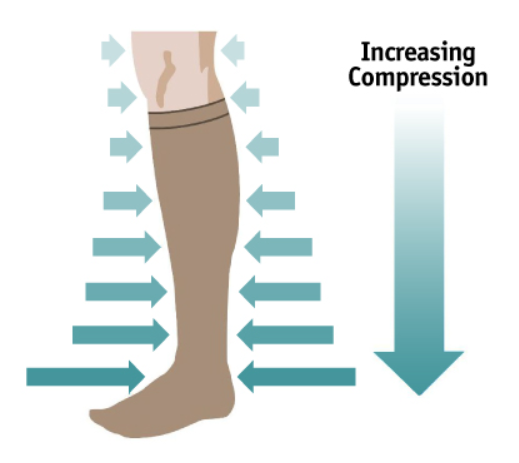
You have now learned that compression socks and stockings are applied to help in the relief of achy and fatigued legs, swollen ankles and feet, and to enhance the flow of blood. These products are available in varying pressure levels. The measurement that is often used for compression socks is mmHg or millimeters of Mercury.
The higher the number of mmHg, the higher the pressure will feel on the legs.
The various levels of pressure are worn to help with different medical conditions. The best way to confirm the best pressure level for you is to discuss it with your physician or doctor. A pharmacist at your local pharmacy may also be able to help you determine what type of compression socks you need. Below is the breakdown of the varying pressure levels.
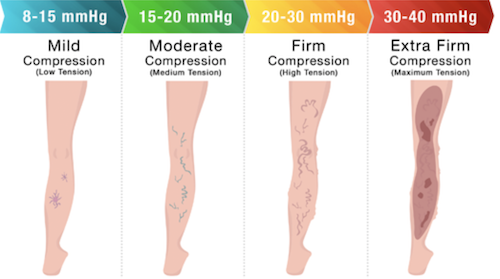
8-15mmHg (Mild Compression)
- Some TED Hose are in this category.
- Provides relief to achy legs and fatigue
- Helps to relieve minor swelling associated with long hours of sitting or standing
- Promotes healthy circulation in legs
15-20mmHg (Moderate Compression) – Most TED Hose are here (this level of compression is effective for treatment of non-ambulatory, aka bed bound, patients)
- Most TED Hose are in this category.
- Used during pregnancy to help prevent varicose veins
- The best pressure to use when a person is traveling long distances
- Used for the relief and prevention of minor to moderate spider veins and varicose
- Prescribed in post-sclerotherapy treatment to assist in the prevention of reappearance of spider veins and varicose veins
- Used in treatment for Deep Vein Thrombosis
- Most TED Hose are not registered trademarks ® or trademarks ™. Instead, look for an established company to make sure you’re getting good quality T.E.D. Stockings.
20-30mmHg (Firm Compression)
- These are *not* TED hose. These are compression stockings meant for walking around.
- Used in the treatment of minor to chronic lymphatic edema and edema
- Applied during pregnancy to help the person prevent varicose veins and for slight swelling of the ankles
- Helpful for the prevention and relief of severe and moderate varicose veins
- Assists in the management of signs of post-thrombotic syndrome and active ulcers.
- ComproGear Compression Socks come in these compression levels.
30-40mmHg (Extra Firm Compression)
- For relief and prevention of chronic spider veins and varicose
- Used in post-sclerotherapy and post-surgical treatment to assist in lessening the reappearance of spider veins and varicose
- Recommended for application during pregnancy only under a doctor’s guidance
- Used in the treatment of chronic lymphedema and edema
- It helps in the reduction of Postural Hypotension and Orthostatic Hypotension symptoms.
- Helps in the management of manifestations of Post-Thrombotic Syndrome and Venous Ulcers.
- Applied for treating and the prevention of deep vein thrombosis (DVT)
Measuring For Compression Socks
Measurements You Might Want for Measuring TED Stockings / TED Hose
Compression socks can be completely ineffective if they don’t fit right. Many people have found themselves accidentally buying compression socks for men when what they really needed was compression socks for women. Or people have purchased compression stockings when they really needed TED Hose.
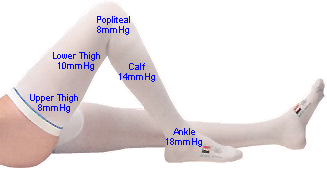
Make sure to measure your feet before buying compression socks or TED Hose, so you will be able to get just the perfect size and fit for your feet.
Take the measurements early in the morning before your ankles and feet begin to swell. It’s best to take the measurement immediately as you get out of bed first thing in the morning. This is the time of day when you’ll be putting your compression socks on. This is also the time of day you’ll be putting on your TED Hose. Keep in mind TED hose are usually worn more of the day than compression stockings or socks would be.
You can use a body tape measure to take the measurements of your feet. You can also use a string and then measure the string with a ruler after measuring your feet if you don’t happen to have a body tape measure.
Make sure to use straight and untwisted strings and tape measure when measuring your feet, otherwise your measurements will be inaccurate and you will end up buying compression socks that don’t fit.
Make sure you take the measurements with your bare feet and do not wear socks while taking the measurements. It does not matter if you are looking to buy knee-high or thigh-high versions, you will have to take measurements. You may need help from a family member or friend in order to get these measurements just right.
Ankle Circumference: Turn the tape around the smallest part of the ankle, directly above the ankle bone.
Calf Circumference: Take the measurement around the biggest part of your calf. You may have to measure various parts of the calf to ensure that you measure the biggest part of the calf.
Knee Length: You will need to know the length of your knee if you are buying Knee High variants. Start your measurement from behind your knee, just below the bend to where your heel stops. Make sure your measurement starts from below the curve of your knee.
Thigh Circumference: Take the measurement around the biggest part of your thigh.
Leg Length: You will need to know the length of your entire leg if you are looking to buy Thigh High variants. Start your measurement from behind your heel to the top of your thigh. Ensure that you make use of a straight tape measure.
Note:
People with longer toes may feel more comfortable wearing open-toed versions of compression hose or socks. Open toe socks may feel better for certain people because the toes will feel freer instead of being cramped up like in the closed-toe versions.
What’s the Best Way to Put On T.E.D. Hose?
Once you’ve gotten your T.E.D. hose measurements down, it’s time to get started on wearing them. People who wear T.E.D. Stockings are typically bedridden (“TED s are for BED s”)and will probably need help with getting their compression stockings on properly so that they can do their job well. If you’re wearing them after surgery, your doctor or another medical care provider should educate you on how to put on your T.E.D. stockings.
Your instructions on how to put on your stockings will likely go something like this:
- Put your hose on first thing in the morning.
- Lie down, elevating your legs on a pillow for about 15 minutes before putting on the garment.
- Apply a small amount of powder to your ankles to ease the stockings over your legs. (Consult with your healthcare provider or doctor on the kind of powder to be used.)
- Pull up the stocking gradually onto your foot. Gather the loose material, using a short, quick pull to get the whole compression garment up your leg to the thigh.
- Repeat for the other leg, then shift your weight so you can get the hose around your midsection.
What Else Do I Need To Know About T.E.D. Hose?
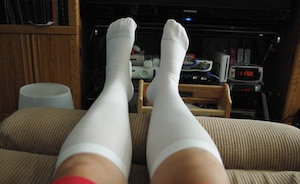
- Your stockings should be worn all day or as prescribed. You may be instructed to put them on while sleeping at night, as well, if you are completely bedridden.
- Be sure to check your toes for discoloration or temperature changes every 4 hours during the day. If you notice changes in your toes, remove the pressure garment immediately.
- Always keep the fabric smooth and in one place. Don’t allow them to roll down at the top or even wrinkle. Wrinkles in your hose can prevent blood flow to your feet and legs which could ultimately cause undue pressure and result in damage to the skin as well as uneven circulation.
- Take off your compression garments as directed and wash them. Also, wash your legs and look out for damaged skin or a rash when you undress.
- Wash the T. E.D. Socks using warm water and mild soap. You may also be instructed to put on another pair while you wash the first pair in order to keep the consistency of your care.
- If your stockings don’t fit properly or get damaged, get new ones right away.
When Should I Contact My Health Care Provider?
Contact your healthcare provider if:
- Your legs or feet feel cold and can’t seem to get warm.
- Your toes swell, look blue, or you have difficulty moving them.
- You have pain or leg cramps.
- You have concerns or questions about your condition or care.
- You’re not 100% sure your TED hose fit correctly.
T.E.D. stockings are made to be very durable but they won’t last forever. Which, for most people, is fine because they are often prescribed temporarily after surgery. Expect a good pair of TED Hose to last about three months (depending on how many pairs you own and can rotate through).
Conclusion
We’ve now learned that T.E.D. Stockings (also known as TED Hose)and Compression Socks are two different types of socks. Although both are used in the medical field, they are similar but have different uses. The T.E.D. Hose is used for non-ambulatory patients (patients that can’t move around on their own), while Compression Socks are used for mobile patients who simply need more pressure on their legs.
Make sure that you seek advice from your doctor before buying TED Hose, T.E.D. Pantyhose, or TED Stockings. Your physician or pharmacist can help you decide which type of TED Hose or Compression Sock is best for you. The most important thing is to get a pair of T.E.D. Stockings if you are planning to undergo surgery, then wear them as instructed.
This page last updated December 10, 2022
